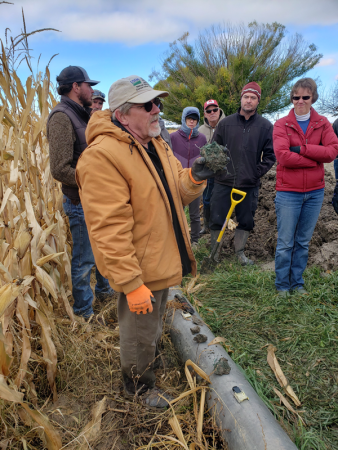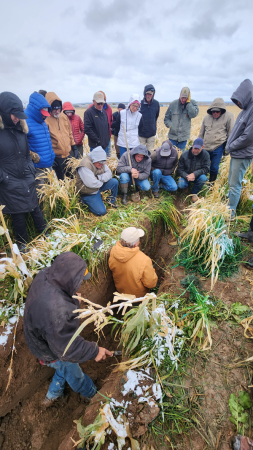Written by Mendy Stewart, Education Coordinator for the Shavano Conservation District
In October 2022, despite snow and cold, local farmers and soil health enthusiasts gathered to see Rick Strait’s demonstration on water infiltration.
Rick is the New Mexico State Soil Scientist for the Natural Resource Conservation Service, US Department of Agriculture. The Shavano Conservation District’s annual Soil Health Field Tour visited 2 farm fields and a location on BLM rangeland where Strait used blue food coloring and 30 gallons of water to demonstrate water movement through the soil.
“The problem with water is that it is clear, making it sometimes difficult to see where it is moving," said Strait.
He explained that the fun part for him is taking a soil research experiment (referred to as using a dye tracer) and using common tools to make it into a demonstration anyone can do to see the physical properties of their field through water movement in the root zone and below.
Two days prior to the Field Tour, Strait visited each site to pour blue food coloring and a slow drip of 30 gallons of water in a three foot diameter ring. After the blue water had 24 hours to saturate the surface and soak into the ground, Strait returned to the sites with a backhoe to bi-sect the test areas. The walls of the resulting soil pits told a story of water movement through the soil.
Soil pits dug on fields with conventional tillage practices and minimum-tillage showed where the dye had moved down to the plow-pan layer in the soil and then moved laterally across the soil, rather than going farther down. Soil pits dug in the no-till field showed the dye (water infiltration in the soil) went down 5 feet and did not encounter a plow-pan. A closer look at the granulated soil structure at the no-till location also revealed blue food coloring in root holes and worm casings where the water moved the dye through the soil.
According to Strait, soil testing gives a picture of the chemical properties (nutrients) in the soil, whereas the dye tracer test gives a picture of the physical properties of the soil.
“If you have a spot in your field that is not producing as much, but the soil tests show the nutrients in the soil are the same as the rest of the field, chances are the physical properties in the soil are different in that spot,” said Strait.
The deeper the water can move into the soil, the more water storage a farmer has in their soil. As we are all becoming increasingly aware, water storage is a big deal.
Fields visited on the tour were all enrolled in the Colorado Department of Agriculture’s STAR+ Program (Saving Tomorrow’s Agricultural Resources).
Colorado STAR and STAR Plus Programs make up the Colorado Soil Health Program. The Star Program helps individual farmers and ranchers evaluate their operations’ use of soil health practices and identify areas for improvement while providing technical and financial assistance to help them succeed. This tour group visited local fields enrolled in the STAR+ program and learned about soil health practices they implemented this season.
This regional soil health event is organized with support from the Western Colorado Soil Health Team and the Colorado State Conservation Board’s Matching Grants Program.
CSCB provides matching state funds to conservation districts for implementing private lands on-the-ground conservation projects and educational conservation activities. Demonstrations such as the dye tracer that was used on this tour are providing opportunities for local farmers and ranchers to see soil research in practical application, giving them more tools for operational resiliency.

